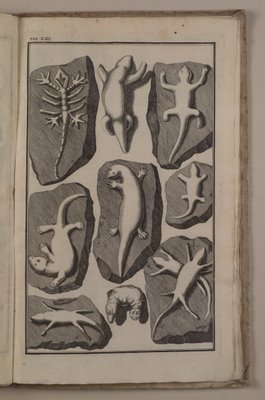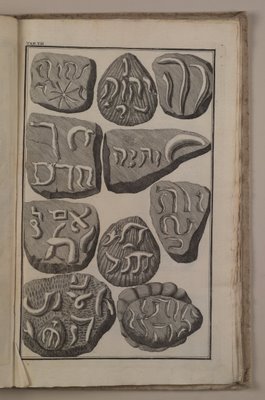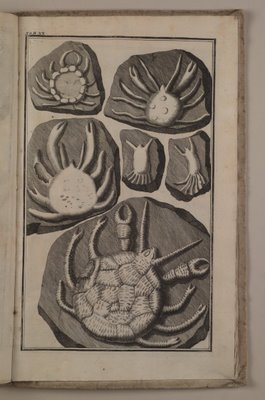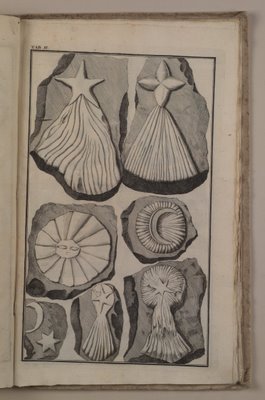









You would think that being Dean of the Faculty at Würzburg University in Germany, Chief Physician at a renowned hospital, Doctor to the powerful Prince-Bishop of the region and author of important medical papers in the early 18th century would ensure a notable and respected legacy. You would think.
But if you combine such a professional resume with a sideline interest in natural history and a more than healthy dose of arrogance and a talent for making enemies, then you would be sketching the background to a remarkable episode in the annals of geology and paleontology.
Johann BA Beringer was a keen natural scientist who collected petrified specimens for display and as lecture material from nearby Mount Eivlstadt; or at least, as was the usual practice of the day, he paid minions to do his field work.
Unbeknownst to Beringer, two of his professional
Current wisdom puts the number of these bogus fossils produced (over a period of less than a year) at around 2000. It has been estimated that a single carving may have taken up to 6 hours to make. This was a serious stunt. And Beringer fell for it so completely that even when it was overtly put to him when he was preparing a book on the subject that the fossils were fake and had been produced in recent times, he refused to accept this as a possible explanation.
You can see in the above illustrations from the very very rare 1726 first edition of 'Lithographiae Wirceburgensis' that the stones not only included impossible soft tissue elements in the 'fossil' outlines, but that some of them included impressions of comets and the sun and even hebrew and arabic text!
Beringer discussed possible natural phenomena in his book to explain the unusual specimens. To be fair, the general knowledge at the time about the mechanisms causing fossilization was at best fanciful. The 'plastica' theory had fossils growing spontaneously inside rocks and the 'spermatic' theory had the seed from modern marine animals entering rocks through cracks.
So although Beringer was totally duped, the overall climate of amazing scientific discovery and theorizing across many subject areas, must have lent the study of this unknown world of paleontology a particularly naive impetus. (Amazingly, Beringer considered that the fossils could not have been remnants from the biblical flood because an acorn impression signified it was the wrong time of year!)
Legend has it that soon after the book was published either Beringer himself or one of his collectors found a stone on which was carved Beringer's own name. It is said that this was the piece of evidence that finally convinced Beringer that he had been the subject of a vast hoax. He successfully sued the two instigators and regained some of his professional integrity but he never published another natural history paper. He died in 1740.
"Beringer has become a symbol of the gullible, and, too often in academic circles, an object of humorous mockery." I think it's hard, after reading a number of different versions of the events that occurred, not to have some level of sympathy for Beringer (well, after laughing of course).
The fake stones which came to be known as 'Lügensteine' -- 'The Lying Stones' -- are said to be quite valuable as novelty collectors' items: there are a few hundred still in existence today.
- The complete 1726 'Lithographiae Wirceburgensis', including 21 illustration plates, is online at the University of Bologna (click 'Tab.' in the sidebar dropdown menu for the fossil images in jpeg format -- if you have a DjVu plugin, the saved images are much bigger)
- This brief editorial, 'Fossils and Compassion' from Ariel A Roth at the Geoscience Research Institute seems about the best/unembellished rendition of the story.
- Program transcript from the Science Show (ABC Australia) of an interview with a paleontologist at the Natural History Museum in the UK.
- University of Minnesota Geology Department 'Conspiracies, Fraud and Deception in Earth History' ('The Lying Stones of Dr. Beringer') - the chapter titles to the book in english are partway down the page.
- 'The Lying Stones of Dr. Beringer' at the Museum of Hoaxes.
- A copy of 'Lithographiae Wirceburgensis' for $13,000 {some stories have it that Beringer went nearly bankrupt buying up as many copies of the first edition as he could and then destroying them. A 2nd edition was released after his death anyway. I believe an english edition was published in 1963 and/or it might have simply been the authoritative biography of the fake fossils episode - I didn't dig deeply on this.)
- The UK Natural History Museum have a few images of the fake fossils but this particular image is the best I found.
- 'GeoFakes Frauds and Hoaxes' - Abstracts - from the Geological Society.
- The Guardian - all time favourite science scams of Tim Radford (2003).
- [There is a lot more around online about the Beringer story, much of it either exaggerated or embroidered]
- UPDATE: The University of Heidelberg has posted their copy of 'Lithographiae Wirceurgensis' online.
- UPDATE: The Bavarian State Library has posted their copy of 'Lithographia Wirceburgensis' online (15 July, 2012)
Beringer is my new hero!
ReplyDeleteFELICITACIONES POR SU BLOG MAGNIFICO, lo dimos a conocer en nuestro blog institucional:
ReplyDeletehttp://sociedaddebibliofiloschilenos.blogspot.com/
Estaremos en contacto y nuevamente felicitaciones
Neville Blanc Renard
Secretario-Tesorero
Sociedad de Bibliófilos Chilenos
Hi p.k.
ReplyDeleteHave you read "Dinosaurs in the Attic" by Douglas Preston? It describes some of the weird and wonderful things kept in the attics of the New York Natural History Museum. They are never displayed because there is too much material owned by the museum. Complete with some horror stories on the aquisition of some of the pieces - eg the meteorite used by the local Eskimos for their only source of iron and then the "adventures" of getting it onto a ship and home.
I have a favour to ask, if I may.
My blog is at http://elmsleyrose.blogspot.com/
I've uploaded a heap of pictures of my medieval illumination work. However, no matter how large I re-size the image in Photoshop (to 12 Meg or whatever) it's still not being displayed in the detail that I want - life size, let alone a little bigger than life size so my friends can see the detail of the work.
Of course I'm choosing "large" on the upload option and read the Help with no, er, Help. Re-sizing on the Blog Composer leads to pixelation straight away.
Being a image meister, would you be able to help me at all? it would be greatly appreciated.
Regards,
Elmsley Rose
Fossil Fakes reminds me of the hoax Thor Heyerdahl was at the center of regarding Easter Island artifacts. Have you done a blog on those?
ReplyDeleteHere in Italy one of the greatest hoaxes is the one perpetrated by three art students from Livorno in middle eighties…
ReplyDeleteThey claimed to have found in a river three heads sculpted by Amedeo Modigliani.
The students sculpted the heads with a drill, but it took relatively a lot of time for the critics to find out.
Uuh… sorry for my poor english!
By the way, I’m going to link your blog on mine, I hope you don’t mind…